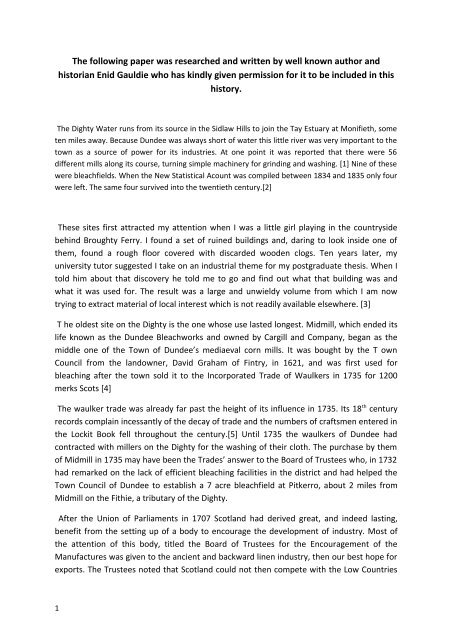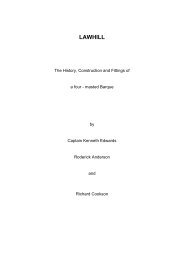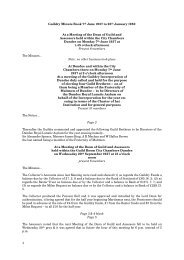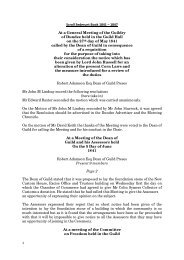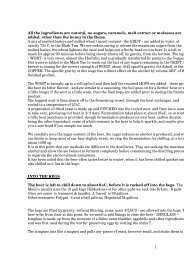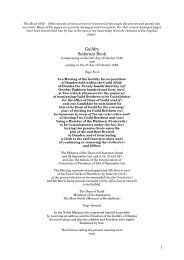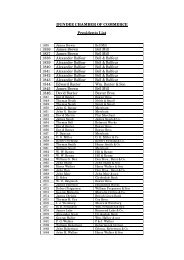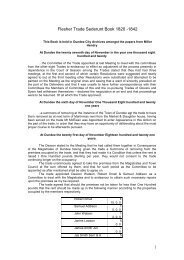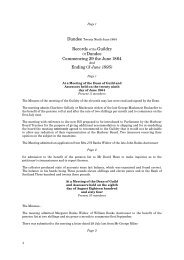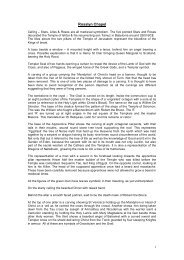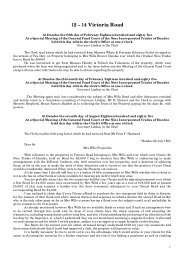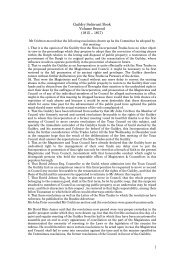The Dichty Mills - Nine Trades of Dundee
The Dichty Mills - Nine Trades of Dundee
The Dichty Mills - Nine Trades of Dundee
You also want an ePaper? Increase the reach of your titles
YUMPU automatically turns print PDFs into web optimized ePapers that Google loves.
<strong>The</strong> following paper was researched and written by well known author and<br />
historian Enid Gauldie who has kindly given permission for it to be included in this<br />
history.<br />
<strong>The</strong> Dighty Water runs from its source in the Sidlaw Hills to join the Tay Estuary at Monifieth, some<br />
ten miles away. Because <strong>Dundee</strong> was always short <strong>of</strong> water this little river was very important to the<br />
town as a source <strong>of</strong> power for its industries. At one point it was reported that there were 56<br />
different mills along its course, turning simple machinery for grinding and washing. [1] <strong>Nine</strong> <strong>of</strong> these<br />
were bleachfields. When the New Statistical Acount was compiled between 1834 and 1835 only four<br />
were left. <strong>The</strong> same four survived into the twentieth century.[2]<br />
<strong>The</strong>se sites first attracted my attention when I was a little girl playing in the countryside<br />
behind Broughty Ferry. I found a set <strong>of</strong> ruined buildings and, daring to look inside one <strong>of</strong><br />
them, found a rough floor covered with discarded wooden clogs. Ten years later, my<br />
university tutor suggested I take on an industrial theme for my postgraduate thesis. When I<br />
told him about that discovery he told me to go and find out what that building was and<br />
what it was used for. <strong>The</strong> result was a large and unwieldy volume from which I am now<br />
trying to extract material <strong>of</strong> local interest which is not readily available elsewhere. [3]<br />
T he oldest site on the Dighty is the one whose use lasted longest. Midmill, which ended its<br />
life known as the <strong>Dundee</strong> Bleachworks and owned by Cargill and Company, began as the<br />
middle one <strong>of</strong> the Town <strong>of</strong> <strong>Dundee</strong>’s mediaeval corn mills. It was bought by the T own<br />
Council from the landowner, David Graham <strong>of</strong> Fintry, in 1621, and was first used for<br />
bleaching after the town sold it to the Incorporated Trade <strong>of</strong> Waulkers in 1735 for 1200<br />
merks Scots [4]<br />
<strong>The</strong> waulker trade was already far past the height <strong>of</strong> its influence in 1735. Its 18 th century<br />
records complain incessantly <strong>of</strong> the decay <strong>of</strong> trade and the numbers <strong>of</strong> craftsmen entered in<br />
the Lockit Book fell throughout the century.[5] Until 1735 the waulkers <strong>of</strong> <strong>Dundee</strong> had<br />
contracted with millers on the Dighty for the washing <strong>of</strong> their cloth. <strong>The</strong> purchase by them<br />
<strong>of</strong> Midmill in 1735 may have been the <strong>Trades</strong>’ answer to the Board <strong>of</strong> Trustees who, in 1732<br />
had remarked on the lack <strong>of</strong> efficient bleaching facilities in the district and had helped the<br />
Town Council <strong>of</strong> <strong>Dundee</strong> to establish a 7 acre bleachfield at Pitkerro, about 2 miles from<br />
Midmill on the Fithie, a tributary <strong>of</strong> the Dighty.<br />
After the Union <strong>of</strong> Parliaments in 1707 Scotland had derived great, and indeed lasting,<br />
benefit from the setting up <strong>of</strong> a body to encourage the development <strong>of</strong> industry. Most <strong>of</strong><br />
the attention <strong>of</strong> this body, titled the Board <strong>of</strong> Trustees for the Encouragement <strong>of</strong> the<br />
Manufactures was given to the ancient and backward linen industry, then our best hope for<br />
exports. <strong>The</strong> Trustees noted that Scotland could not then compete with the Low Countries<br />
1
in the bleaching and finishing <strong>of</strong> linens and they brought over skilled workers and awarded<br />
prizes for improvements in that department.<br />
No attempt was made by the Waulkers to seek guidance or financial help from the Trustees,<br />
although without the approval <strong>of</strong> that body it is hard to see how any bleaching venture<br />
could succeed in that period. Midmill was used only as the most primitive kind <strong>of</strong> washing<br />
mill, not as a bleachfield in any modern sense <strong>of</strong> the word, throughout the 18 th century. It<br />
was not <strong>of</strong> sufficient importance to be mentioned in the Old Statistical Account and can<br />
have been <strong>of</strong> little consequence either to the Town <strong>of</strong> <strong>Dundee</strong> or to the Incorporated Trade<br />
<strong>of</strong> a Waulkers, whose records, as published, do not mention it. In 1823 the Incorporation<br />
had been reduced to one member and would have ceased to exist had it not been found<br />
necessary for political[6] reasons, to provide artificial respiration.<br />
<strong>The</strong> means chosen to revive the ancient corporation as a body with voting powers in the<br />
town could do nothing for its business activities. Midmill reverted to ownership <strong>of</strong> the Town<br />
Council who let it out to William Brown, [7] at that time operating a spinning mill at Trottick,<br />
close by. Trottick mill [8] was burned down for the second time in 1811 and Brown’s<br />
attention became concentrated on his spinning ventures within the town’s boundaries,<br />
West Ward Mill, founded 1806 and East Ward Mill, founded 1809 .<strong>The</strong> bleaching business at<br />
Midmill then failed . [9]. James Berrie and Miller Berrie took over the business in about<br />
1818[10]<br />
<strong>The</strong> source <strong>of</strong> the Berrie capital is not known for certain but we know that James Berrie was<br />
already engaged in the linen trade in <strong>Dundee</strong> [11] and may have accumulated capital for<br />
investment in bleaching through his linen dealing activities. James was also brother-in-law<br />
to James Carmichel, the well known engineer, whose interest in the linen trade had already<br />
led him to invest capital in a spinning mill and may perhaps have induced him to provide<br />
some backing for the Berries’ establishment at Midmill.<br />
Under the Berries the firm handled a fair proportion <strong>of</strong> the town’s bleaching business and<br />
provided employment for a fluctuating number <strong>of</strong> men and women which varied from seven<br />
in winter to thirty in summer[12] <strong>The</strong> years between 1811 and 1842 were not easy ones for<br />
the linen trade. T he town’s principal bleacher went bankrupt twice during the period and in<br />
1842 the town itself was bankrupt.[13] <strong>The</strong> Berries failed in 1838. <strong>The</strong> business at Midmill<br />
was then run by John Laing, Kinmond and Hill with Joseph Duncan as the managing partner.<br />
<strong>The</strong>y carried on until 1851.<br />
Midmill was now mortgaged to the <strong>Dundee</strong> Bank. Duncan’s trustees sold the firm to the<br />
bank by public roup, the object being to get a better title to the property. In 1854 Cargill and<br />
Company bought the works from the <strong>Dundee</strong> Bank on terms <strong>of</strong> gradual payment for £3,250.<br />
[14]<br />
2
Although this seems to represent a very large increase on the purchase price <strong>of</strong> 1,200 merks<br />
for the same property in 1735 it was not a large amount for a well situated bleachfield.<br />
Borland and Company had spent more than £4,000 on their field sixty years earlier.<br />
In fact very large amounts <strong>of</strong> capital were not required for the setting up <strong>of</strong> a bleachfield.<br />
<strong>The</strong> basic equipment <strong>of</strong> the linen bleacher remained the same throughout the eighteenth<br />
and nineteenth centuries. <strong>The</strong> only essential powered machines were wash mills and<br />
beetles and these were known in the first half <strong>of</strong> the 18 th century. <strong>The</strong> water wheel which<br />
turned them very <strong>of</strong>ten preceded the rest <strong>of</strong> the works, having been inherited from much<br />
earlier establishments on the same fall <strong>of</strong> the river, usually tuke, or washing mills or, even<br />
earlier, meal grinding mills. [15]<br />
<strong>The</strong> new owners, Cargill and Company were not Dundonians. Cargill was one <strong>of</strong> the many<br />
hundreds <strong>of</strong> linen trade workers attracted into the growing industrial city from the declining<br />
towns in the counties <strong>of</strong> Angus and Perthshire.<br />
<strong>The</strong>re was still a Cargill at Midmill when I came to explore it and he was extremely generous<br />
with his time and interest, allowing me to see everything that had survived and to meet and<br />
question elderly ex employees who had worked at the bleachfields. My great regret is that<br />
when I was privileged to explore these early sites, then almost as they had been for a<br />
century or more, I had neither the knowledge, the techniques, or the back up to do them<br />
justice. I had no camera, I could not draw, I had no technical ability. And, the pr<strong>of</strong>ession <strong>of</strong><br />
Industrial Archaeology not yet invented, I had no one to turn to for advice. Neither<br />
University or City employed pr<strong>of</strong>essional archivists in those days I did have the wit to<br />
recognise that these were valuable historical sites, every bit as valuable as the more<br />
fashionable Pictish villages and Viking tombs, and I recorded them as best I could. Eventually<br />
my researches were noticed. I was particularly lucky to attract the interest <strong>of</strong> two men, from<br />
different parts <strong>of</strong> the world, <strong>of</strong> great distinction in the field <strong>of</strong> mill studies. <strong>The</strong> first was<br />
Anders Jespersen <strong>of</strong> Copenhagen, one <strong>of</strong> the great molinologists. <strong>The</strong> second was Rex<br />
Wailes, a retired engineer and expert on windmills. <strong>The</strong>y both became treasured friends and<br />
between them extended my knowledge and showed me how to go about things.[16]<br />
But I had no weight when it came to pushing my case When I tried to persuade town<br />
councillors that Midmill should be preserved as an important part <strong>of</strong> <strong>Dundee</strong>’s history, I was<br />
told that a choice had to be made between much needed schools and houses and not so<br />
important heritage sites. And now there is a large school and acres <strong>of</strong> housing where<br />
Midmill once stood. I was so lucky to see those vast echoing sheds with their ancient coal<br />
fired boilers, their huge vats for soaking the goods in chemicals, the tall calendars for<br />
mangling, the 13 foot water wheel which turned them. And perhaps I was even more lucky<br />
to talk to people who had worked them, both there and at Baluniefield, the floor swimming<br />
in water, the wind and even snow blowing through the louvred walls. <strong>The</strong>y showed me a<br />
range <strong>of</strong> sheds still known to workers as the ‘Crimies’ because they had been first erected to<br />
meet a rush <strong>of</strong> military orders for the War in the Crimea. <strong>The</strong>y told me how they had paid a<br />
3
minder sixpence a week to look after their children, how hard the work was, how cold, but<br />
how much they preferred it to working in the spinning mills in town. It was quiet in the<br />
bleachworks. You could gossip and talk and you were not tied to one repetitive process all<br />
day long.<br />
Cargills had, in fact taken over at a time <strong>of</strong> upturn in the trade. War was always good for<br />
business in <strong>Dundee</strong>. However the boom was soon over. In 1856 an article about the trade <strong>of</strong><br />
<strong>Dundee</strong> reported that ‘latterly, owing to the great advance in the price <strong>of</strong> bleaching<br />
materials and also <strong>of</strong> labour the trade is not a paying one, prices <strong>of</strong> bleaching having<br />
continued the same, while some colours leave an actual loss.’[16] <strong>The</strong>re was, it was said, too<br />
much competition among bleachers and prices were run down unnecessarily.<br />
For competition on the Dighty Cargill had to face the long established firm <strong>of</strong> Turnbull and<br />
Company at Claverhouse, John McIntyre at Douglasfield and Daniel Drimmie at<br />
Panmurefield. Drimmie had come from Aberdeen, where his father was a bleacher, to set<br />
up business on the Dighty in 1839. Some <strong>of</strong> the manufacturing firms in <strong>Dundee</strong>, notably<br />
Cox’s at their Camperdown Works, also handled their own bleaching.<br />
Midmill was the only one to remain in the same hands throughout the next century and the<br />
only one still operating when I began to explore their history. It was well placed on the river,<br />
being sufficiently far from Claverhouse for polluted water to have cleared before it reached<br />
the dams and settling ponds and sufficiently near to the next bleachfield down river to<br />
harass the competitors there. To make the position even more secure Midmill bought up<br />
the small plash mills up river, not for their value as mills, but for the water rights they gave.<br />
<strong>The</strong> age <strong>of</strong> these primitive plash, or washing, mills cannot be certain but they probably<br />
existed in the seventeenth century. <strong>The</strong> names <strong>of</strong> Honeygreen and Fountainbleau, both <strong>of</strong><br />
which were acquired in the 1850s, are now preserved only as street names in <strong>Dundee</strong>’s<br />
northernmost housing scheme.[17]<br />
In spite <strong>of</strong> the introduction <strong>of</strong> jute, <strong>Dundee</strong>’s linen production increased fairly steadily in<br />
the next twenty years. In 1848, 47512 tons <strong>of</strong> flax were imported to East Coast ports. In<br />
1862 the figure had risen to 54586 tons. Jute had risen from 8905 tons in 1848 to 38,277<br />
tons in 1862. <strong>The</strong> increased prosperity <strong>of</strong> the town was reflected in all branches <strong>of</strong> the<br />
trade, and, even in these years <strong>of</strong> great increase in jute production, linen suffered no real<br />
decline, but only a decline in relative importance. [18]<br />
Midmill , with a good water supply and placed on a main road into the town, was in a good<br />
position to take advantage <strong>of</strong> the opportunities the town’s prosperity <strong>of</strong>fered.<br />
<strong>The</strong> firm built cottages and bothies for their workers. <strong>The</strong> year after starting business Cargill<br />
was faced with the visit <strong>of</strong> the Queen’s Commissioner inspecting the open air bleachfields<br />
and was able to claim that his emploerciseryees already worked under the conditions<br />
suggested in the proposed bill. He testified that he found it more pr<strong>of</strong>itable to employ men<br />
during reasonable hours than to attempt to extract responsible work from grossly over tired<br />
4
workers. It was a position that contrasted strongly with the protestations against the bill by<br />
the master bleachers <strong>of</strong> Perth. Cargill and Company were linen yarn bleachers only, handling<br />
a smaller and less valuable product than the linen and cotton cloth manufacturers <strong>of</strong> Perth,<br />
exercising less skill and expecting less pr<strong>of</strong>it.<br />
Linen bleaching, until the Second World War, still involved the ‘grassing’ or ‘cr<strong>of</strong>ting’ <strong>of</strong><br />
yarn, with fairly lengthy and repeated periods <strong>of</strong> exposure to sun and air. <strong>The</strong> lack <strong>of</strong> reliable<br />
sunshine in Scotland meant that cloth might be laid and lifted time and again as sudden<br />
showers or frosts threatened. This involved, in the constant shifting <strong>of</strong> wet weights <strong>of</strong> linen,<br />
excessively heavy labour and made bleach masters attempt to get through the bulk <strong>of</strong> their<br />
orders in the more clement months <strong>of</strong> the year. To do this they engaged large numbers <strong>of</strong><br />
workers who were employed for a season and paid <strong>of</strong>f in the winter. So there were two<br />
kinds <strong>of</strong> worker employed at bleachfields, those employed only seasonally and a permanent<br />
core <strong>of</strong> men and women who worked full time and all year round on the same premises.<br />
This core consisted <strong>of</strong> the skilled workers and maintenance men. To maintain an efficient<br />
organisation it was necessary to provide accommodation which would keep these people<br />
loyal to the firm for which they worked. Not only for the usual reasons <strong>of</strong> efficiency was it<br />
desirable to keep a steady population <strong>of</strong> workers on bleachfield premises. Bleach masters<br />
had a special reason for not wanting to lose their trusted workers to other firms. Many <strong>of</strong><br />
the processes involved in bleaching were closely guarded secrets. <strong>The</strong> exact ingredients and<br />
techniques were carefully protected from leakage <strong>of</strong> information. Each firm gave a<br />
distinctive finish to its cloth or yarn. Orders were placed by merchants for that particular<br />
finish which could not be supplied to exactly the same specification by a rival. It was,<br />
therefore very much in the firm’s interest to maintain a happy work force that was not<br />
anxious to move.<br />
<strong>The</strong> best way to do this was to provide houses for workers and their families within the<br />
bleaching village. Employment was <strong>of</strong>ten then available for both husband and wife with the<br />
promise <strong>of</strong> future work for their children. <strong>The</strong> worker most unlikely to leave his master was<br />
the one contentedly housed. <strong>The</strong>re was a need for two different kinds <strong>of</strong> housing,<br />
temporary accommodation for a migrant work force, permanent dwellings for a core <strong>of</strong><br />
skilled workers and their families. Single people were put up in bothies. Although much<br />
criticised, especially by parish ministers who saw them as dens <strong>of</strong> immorality, the bothies in<br />
fact probably provided more comfortable accommodation than the cottages the people had<br />
left behind. Structurally sound and well ro<strong>of</strong>ed, there was a better chance <strong>of</strong> the bothy<br />
being dry than many rural cottages had provided. I saw and photographed some <strong>of</strong> these<br />
bleachfield bothies just before they were demolished.[ 19] One whole end wall would be<br />
taken up by the huge fireplace on which the people cooked their food and dried their<br />
clothes. <strong>The</strong> range at Claverhouse in the late 19 th century ate 82 tons <strong>of</strong> coal a year.[20]<br />
Bunk beds with chaff mattresses and woollen blankets were provided, some on the ground<br />
5
floor, some in the floored gallery above which was reached by a ladder. Cargill and<br />
Company, at Midmill, made an allowance <strong>of</strong> whisky to the watchman, one <strong>of</strong> whose jobs<br />
was to lock the door <strong>of</strong> the women’s bothy at night.<br />
A distinction, when discussing working conditions has to be made between Eastern and<br />
Western Scotland, between cotton and linen works. In Paisley, for instance, a “woman<br />
house” inside the works had women sleeping three to a bed, the beds pushed together to<br />
accommodate as many as possible. Sick lay in the same beds with the healthy.[21] But, in<br />
the linen bleachfields the bothy remained both a friendly and a comfortable place, in which<br />
girls from the Highlands, who came for a season, <strong>of</strong>ten gladly remained for years until they<br />
‘married out <strong>of</strong> the bothy’.[22] Not all Highlanders at bleachfields were part <strong>of</strong> the seasonal<br />
population. Some did settle and raise their families. Eighteen out <strong>of</strong> fifty three names on<br />
Midmill wage list in 1836 are Highland names. [23] At one time Midmill’s management<br />
employed a Gaelic speakng foreman to supervise the non English speaking section <strong>of</strong> their<br />
workers. Bothy accommodation was suitable only for the young and unmarried. In the linen<br />
fields, because the work was heavier and more <strong>of</strong>ten took place outdoors, a larger number<br />
<strong>of</strong> men was employed . Only twelve out <strong>of</strong> fifty three workers at Midmill in 1838 were<br />
women.[24]<strong>The</strong> necessary distance <strong>of</strong> bleachfields from towns, caused by the need for<br />
space and water power, made the provision <strong>of</strong> family type cottages important. A row <strong>of</strong><br />
terraced housing built to house Baluniefield workers can still be seen on Pitkerro Road, now<br />
within the <strong>Dundee</strong> boundaries although, when they were built, some distance from other<br />
settlements.<br />
<strong>The</strong> owning <strong>of</strong> bleachfield villages encouraged employers to take an interest in the welfare<br />
<strong>of</strong> their employees. For some this was an honest humanitarian principle, for others a<br />
rational care for the capital the workers represented, for most a reasonably sensible<br />
combination <strong>of</strong> the two points <strong>of</strong> view.<br />
<strong>The</strong> oldest <strong>of</strong> the Dighty sites to be operated as bleachfield and not only as waulk mill was<br />
Douglasfield. First mention <strong>of</strong> it occurs in 1756 when Milton Haugh Field[25] in the parish <strong>of</strong><br />
<strong>Dundee</strong> and the shire <strong>of</strong> Forfar, owned by John Speid, bleacher, was granted £50 by the<br />
Board <strong>of</strong> Trustees towards the cost or erecting a bleachfield there. In the same year Hector<br />
Turnbull, <strong>of</strong> Luncarty, Perth, was given permission to instruct Alexander Morison <strong>of</strong> <strong>Dundee</strong><br />
in the secrets <strong>of</strong> bleaching “upon his giving security not to divulge the method.”[26]<br />
This field was, for the first two or three years, called Speid and Yeaman’s, thereafter<br />
Douglasfield. Milton Haughfield is not used again, although the name can be seen on some<br />
maps <strong>of</strong> the Digthy bleachfields. John Speid and Patrick Yeaman were both members <strong>of</strong> the<br />
Incorporated Waulker Trade <strong>of</strong> <strong>Dundee</strong>, and it is perhaps a not unconnected fact that they<br />
were very disinclined to submit to the discipline <strong>of</strong> the central authority <strong>of</strong> the Linen<br />
Trustees.[27] Yeaman was five times Provost <strong>of</strong> <strong>Dundee</strong> and his name lives on in Yeaman’s<br />
Shore. Speid, or perhaps his son, was later employed by the Trustees as a stamp master.[28]<br />
6
Morison was at first an employee, having come to <strong>Dundee</strong> from Perth, and the original<br />
capital for the venture came from Speid and Yeaman. But before long the firm was<br />
Morison’s and he was also dealing in linens in <strong>Dundee</strong> with considerable success.[29] He<br />
had accumulated, by 1792, sufficient capital to indulge in a scheme , in which Robert<br />
Dunsmore, George Dempster and other landed gentlemen were also involved, to bring the<br />
textile industry to the County <strong>of</strong> Sutherland.[30] We know that his financial resources were<br />
not exhausted by this venture because, in 1797, he installed a Boulton and Watt engine at<br />
Douglasfield,[31]<br />
Morison’s daughter Jane married William Sandeman, eighth son <strong>of</strong> William Sandeman, the<br />
distinguished Perth bleacher.[32] This had become a very respectable connection. <strong>The</strong> first<br />
William had recorded his coat <strong>of</strong> arms as William Sandeman <strong>of</strong> Luncarty in 1780 (not<br />
without the help <strong>of</strong> the marriage <strong>of</strong> his daughter Sibella to Robert Boswell, clerk to the Lord<br />
Lyon.) Financially it was at this time and even sounder connection.<br />
Morison took his son in law into partnership both in the bleachfield and in the linen dealing<br />
business, and after Morison’s death the firm became known as Sandeman’s. Very much the<br />
largest share <strong>of</strong> the town’s bleaching business fell to Douglasfield in the first quarter <strong>of</strong> the<br />
19 th century. To such an extent was this true that, when Sandeman’s resources failed, in<br />
1810/11 his failure affected the stability <strong>of</strong> the whole town. “T he head bleacher failed for<br />
£70,000 and the banks bridled up their discounts at once, alleging that all the spinners were<br />
creditors <strong>of</strong> the head bleacher.”[33]<br />
Sandeman’s failure was caused by a sudden drop in the world flax prices at a time when he<br />
had large stocks on his hands which had been bought at earlier high prices. <strong>The</strong> consequent<br />
devaluing <strong>of</strong> his stock was a blow from which a business less soundly based could not have<br />
recovered. His recovery, although complete, was not long established before a country-wide<br />
depression in 1825 caused him again to go bankrupt. It was dealing in linens which gave first<br />
Morison and then Sandeman the capital which put their bleaching business in adavance <strong>of</strong><br />
others in the district. <strong>The</strong>y were, for instance, in a position to install power driven machinery<br />
before the end <strong>of</strong> the 18 th century .<br />
But if linen dealing helped the bleaching business, it also made it more vulnerable to drops<br />
in world prices. Because a bleacher did not usually own the goods he handled, and because<br />
his processes took so long, recessions did not immediately affect his output. A crisis might<br />
well have passed while a bleacher was occupied with linens sent for bleaching before the<br />
crisis began. Although long term depression could not help but affect the quantity <strong>of</strong><br />
business handled by bleachers they were not so greatly affected by sudden price drops as<br />
were linen dealers.<br />
From 1825 the Douglasfield bleachfield was operated by William’s son, Robert, and the<br />
trustees <strong>of</strong> his sequestered estate, among whom was William Baxter.[34] It id not ever<br />
recover its earlier position <strong>of</strong> strength and, in 1837, for the first time since the founding <strong>of</strong><br />
7
the <strong>Dundee</strong> Perth and Cupar Advertiser, Douglasfield did not advertise, as it has hitherto<br />
done annually, its intention to lay down cloth for bleaching.<br />
Robert Sandeman continued in business as linen merchant and calenderer in the town <strong>of</strong><br />
<strong>Dundee</strong> and the bleachfield lay idle until it was taken over by a John McIntyre in 1844.<br />
<strong>The</strong> McIntyres were a linen manufacturing family from Glenshee with business interests in<br />
Blairgowrie. John McIntyre managed Douglasfield and, in 1861, acquired the nearby<br />
bleachworks <strong>of</strong> Baluniefield from Charles Norrie, a <strong>Dundee</strong> manufacturer who had begun<br />
bleaching there in 1856. Baluniefield remained in McIntyre hands, operating as W. A.<br />
McIntyre and Company, until 1954.[35]<br />
Neither Douglasfield nor Baluniefield was well placed for clear water. Midmill could, with its<br />
dams and sluices, hold up the supply and inevitably did let down into the river at the end <strong>of</strong><br />
the day fouled water used in its bleaching processes. <strong>The</strong> two lower fields had access only to<br />
as much water as Midmill chose to allow them and they were, as a result, the first on the<br />
river to be hit by drought. To make the situation harder, the level <strong>of</strong> the river on which<br />
Baluniefield, in particular, was built, was liable to flooding when the river was high. Spate<br />
could put the works out <strong>of</strong> action by washing up under the boiler fires and quenching them.<br />
<strong>The</strong> McIntyres had not chosen their site wisely. Its tendency to flooding was not unknown<br />
and had, in fact, been noted in the Old Statistical Account <strong>of</strong> <strong>Dundee</strong>.<br />
“No part <strong>of</strong> the parish is subject to inundations except the bottom where Fithie and Dighty<br />
join” [36] . This was the exact spot on which the Baluniefield bleachfield was built, on<br />
ground which had been an old pendicle cr<strong>of</strong>t.<br />
Douglasfield, during its ascendancy, between 1780 and 1825, had not found the water<br />
situation too difficult. Midmill <strong>of</strong>fered little in the way <strong>of</strong> competition until the second half<br />
<strong>of</strong> the 19 th century. It was only when the trade <strong>of</strong> <strong>Dundee</strong> increased that demands made<br />
upon this not very large water <strong>of</strong> Dighty became too much <strong>of</strong> it to meet.<br />
<strong>The</strong>re are three sources <strong>of</strong> information about the water supply <strong>of</strong> bleachfields in this area.<br />
<strong>The</strong> first is a “Report relative to a drain for Dighty bleachfields, Glammis, 6 th December,<br />
1832.”<br />
“<strong>The</strong> Dighty being a small stream and drying up much in summer, which, from the<br />
contiguity <strong>of</strong> <strong>Dundee</strong>, increase <strong>of</strong> trade, improved modes <strong>of</strong> bleaching, the dregs and wastes<br />
have <strong>of</strong> late years increased so much that during the season in particular the water <strong>of</strong> it is<br />
rendered quite turbid, and becomes a serious nuisance to the under heritors as also<br />
injurious to the bleachfields for the want <strong>of</strong> pure water.<br />
Not only the lower bleachfields but the farmers whose lands bounded the river, objected to<br />
the pollution and a plan was drawn for a system <strong>of</strong> filters with a sewer into which waste<br />
matter could be discharged away from the river.<br />
8
<strong>The</strong> second source has an element <strong>of</strong> the farcical about it. <strong>Dundee</strong>’s rapid population<br />
growth had placed too great a strain on the ancient wells which had served her people for<br />
drinking water for centuries. Some alternative supply was urgently required. Among other<br />
schemes was one for supplying the town with water from the Dighty. In spite <strong>of</strong> evidence<br />
gathered from bleachfield owners that the stream in summer dried to the merest trickle and<br />
that its pollution killed fish within its banks and poisoned cattle and plants upon them the<br />
scheme was taken as far as being presented as a consolidated bill to Parliament in 1835.[37]<br />
A third source <strong>of</strong> information about difficulties <strong>of</strong> water supply for bleachers is the<br />
sequence <strong>of</strong> legal cases in which one bleacher sued another over the pollution <strong>of</strong> the<br />
stream, in which farmers sued bleachers over damage to their crops and which culminated<br />
in the petition <strong>of</strong> appeal to the House <strong>of</strong> Lords <strong>of</strong> McIntyre Brothers, Baluniefield, in 1889.<br />
McIntyres were by that time now also owners <strong>of</strong> Douglasfield.<br />
<strong>The</strong>y had been sued by Messrs Watson and Shield ,Panmurefield, below them on the river,<br />
because, to surmount their own difficulties, they had abstracted water from the Fithie Burn,<br />
which joined the Dighty immediately below their own works. <strong>The</strong> right to dam the water<br />
supply above any works has always been conceded, but the water below a works was<br />
regarded commonly as being the right <strong>of</strong> the next works downstream and not to be<br />
interfered with. Watson and Shields claimed that their works at Panmurefield had been able<br />
to operate with an adequate supply <strong>of</strong> water from the time <strong>of</strong> its establishment by Daniel<br />
Drimmie in 1829 until 1887, when, after McIntyres’ abstraction <strong>of</strong> the Fithie water, it was<br />
found impossible to obtain a supply <strong>of</strong> water on week days.<br />
After exhausting the supply <strong>of</strong> water stored on Sunday they were compelled either to close<br />
their works for the remainder <strong>of</strong> the week or to risk damaging the yarn. McIntyre’s case, as<br />
presented to the House <strong>of</strong> Lords, rested chiefly on their claim to have a right to do as they<br />
were done by- it was the effect <strong>of</strong> Midmill’s operations upon Baluniefield’s work which<br />
forced Baluniefield to endanger Panmurefield’s position. “<strong>The</strong>re are numerous bleachfields<br />
higher up the river than Balunie. Among them are Balmuir, Claverhouse, <strong>Dundee</strong><br />
Bleachworks (Midmill), Douglasfield, Harestane(Trottick), Maryfield and Fountainbleau.<br />
<strong>The</strong>re are also plash mills such as Honeygreen plash mill as well as public works <strong>of</strong> other<br />
kinds, such as Rosemill manure and sulphuric acid works… <strong>The</strong> <strong>Dundee</strong> Bleachworks is the<br />
largest on the Dighty and one <strong>of</strong> the largest bleachworks in Scotland. After the water passes<br />
these works it is no longer fit on ordinary work days for bleaching or other manufacturing<br />
process but only for turning water wheels. <strong>The</strong> respondents have for a considerable time<br />
conceived the idea <strong>of</strong> abstracting water from the Fithie Burn for the purpose <strong>of</strong> their<br />
bleachworks in order to save them buying the <strong>Dundee</strong> town water which they have hitherto<br />
used.”{38]<br />
<strong>The</strong> amalgamation <strong>of</strong> Baluniefield and Douglasfield in McIntyre hands helped less than had<br />
been hoped because Douglasfield’s own supply had been so materially affected by its<br />
proximity to Midmill. Panmurefield , which had passed from Drimmie to Watson and Shields<br />
9
etween 1860 and 1887, was bought by Midmill in 1927 and closed down in 1932. Its<br />
limited usefulsness had not justified the replacement <strong>of</strong> its antiquated machinery while<br />
Midmill, having been reorganised and fitted with new machines, was in a position to handle<br />
the custom <strong>of</strong> both firms on one site.<br />
When I explored them in the 1960s Panmurefield and Baluniefield both stood derelict. Only<br />
the remains <strong>of</strong> buildings and settling ponds betrayed Panmurefield’s century’s use as a<br />
bleachfield but Baluniefield stood for a short while longer complete with ancient buildings<br />
and lay out and some interesting and well preserved water powered machinery.36]<br />
<strong>The</strong> long and expensive legal proceedingshas crippled Baluniefield financially, making<br />
investment in new machinery and the modernisation <strong>of</strong> the works impossible. Although it<br />
continued in existence after the court cases well into the middle <strong>of</strong> the next century it was<br />
not, and could not be, a serious rival to the two large and powerful works upstream.<br />
Midmill,s real competitor was the bleachfield at Claverhouse. With Douglasfield,<br />
Claverhouse had dominated the market for bleached goods since the late 18 th century. It<br />
entered the 19 th century in the hands <strong>of</strong> Thomas Collier and Company who advertised in<br />
1806 that “they have begun to lay down cloth and will continue to bleach this year at last<br />
year’s prices.” [37] <strong>The</strong>ir business was not as widely spread as Sandeman’s. <strong>The</strong>y did not<br />
attempt to compete in the Perth, Aberdeen and Edinburgh areas, but they had agents for<br />
collecting cloth from customers throughout the whole <strong>of</strong> Fife and Forfarshire. In 1812 they<br />
“begged leave to inform the manufacturers <strong>of</strong> <strong>Dundee</strong> and its vicinity that they have fitted<br />
up part <strong>of</strong> their work for the purpose <strong>of</strong> bleaching and boiling all kinds <strong>of</strong> yarns which they<br />
are now able either to bleach or boil and to return dry in a very short time, at any season <strong>of</strong><br />
the year and at moderate prices.”[38]<br />
Collier, like Sandeman at Douglasfield, was hit by the slump in 1811/12 and in 1813 sold his<br />
business to Hector Turnbull <strong>of</strong> Luncarty (whose sister was married to William Sandeman,s<br />
brother.) In a family as interlaced as the Sandeman- Turnbull one the possibilities <strong>of</strong> the site<br />
and existence <strong>of</strong> enough business in he district for two major bleachfields cannot fail to<br />
have been discussed. <strong>The</strong> business <strong>of</strong> Sandeman, Turnbull and Company at Luncarty, near<br />
Perth, had been hit by the some crisis which had destroyed Collier at Claverhouse, crippled<br />
Douglasfield and forced the letting or sale <strong>of</strong> many other bleachfields in the area. But it<br />
seems that, in spite <strong>of</strong> the loss <strong>of</strong> very large sum <strong>of</strong> money by the company, individual<br />
members <strong>of</strong> the family were able to salvage enough capital to begin again with new<br />
businesses. Dr Henry Samuel Boase joined the firm as managing partner in 1838, lived on<br />
the site and was, after Turnbull’s death, wholly in charge <strong>of</strong> the works until his own death in<br />
1883. He was succeeded by is son.[37] This firm, like Midmill, remained a successful<br />
enterprise until after the Second World War, although in its latter years it was absorbed into<br />
Baxter Brothers.<br />
10
Its success was based, like Midmill’s, partly on its position on the river, which ensured it a<br />
clear and uninterrupted water supply. Trottick mill and Rosemill, very much higher upriver,<br />
were acquired for the rights over the water supply. But it also had exceptionally efficient<br />
and intelligent management. Hector Turnbull was the son <strong>of</strong> the man who had been known<br />
as “the best bleacher in Scotland” and brought to the firm his family’s wide experience <strong>of</strong><br />
bleaching over more than half a century. Dr Boase was a trained chemist with an inventive<br />
mind, a liberal attitude and considerable ability in a period when an understanding <strong>of</strong> the<br />
chemical principles involved in bleaching was very necessary but nevertheless not common.<br />
[38]<br />
Of the other bleachfields on the Dighty which appeared for varying lengths <strong>of</strong> time and<br />
went under, none could withstand the tendency which became more pronounced over the<br />
century for more and more work to be handled by fewer and fewer firms. It was inevitable<br />
that those who had the first essential advantage <strong>of</strong> good siting and who had the capital<br />
resources and intelligent backing to exploit that advantage should emerge as the survivors.<br />
It was natural, then, that, because the first bleachers to settle on the Dighty chose the best<br />
river side sites, firms on those sites remained dominant.<br />
<strong>Dundee</strong> is no longer a textile town. <strong>The</strong> Dighty is now just a country stream, its days as a<br />
provider <strong>of</strong> power to an important industrial city quite forgotten. Only the endurance <strong>of</strong><br />
names ending in” field” such as Panmurefield, Douglasfield, Baluniefield, among the housing<br />
schemes and light industries fringing the city commemorates the vanished history <strong>of</strong> linen<br />
bleaching and water power.<br />
Footnotes for Bleachfields on the Dighty<br />
`1] Old Satistical Account, Forfarshire vol. p.<br />
2]<br />
3] This thesis, entitled Scottish Bleachfields, is deposited in <strong>Dundee</strong> Universit Library<br />
4] Warden, A. J. Burgh Laws <strong>of</strong> <strong>Dundee</strong>, 1872, <strong>Dundee</strong> p.549<br />
5] do.<br />
6] Gauldie, Enid, One artful and ambitious individual, Alexander Riddoch, Provost <strong>of</strong> <strong>Dundee</strong>,[1745-<br />
1822] Abertay Historical Society no. 28 <strong>Dundee</strong> 1989, passim.<br />
7]Mr. Cargill’s private diary, 1870<br />
8]Brown, William, Reminiscences <strong>of</strong> flax spinning, <strong>Dundee</strong> 1862<br />
9]Brown, William, Essays in flax spinning and remarks on the management <strong>of</strong> East Mill, <strong>Dundee</strong>,<br />
139-40, <strong>Dundee</strong> University Library, mss<br />
10]do<br />
11
11]<strong>Dundee</strong> Directory, 1818<br />
12] Midmill Pay lists mss.<br />
13]Boase, C.W. A century <strong>of</strong> banking in <strong>Dundee</strong>, Edinburgh, 1867<br />
14] Mr. Cargill’s private diary, mss. Page in my possession.<br />
15]Fuller descriptions <strong>of</strong> bleachfield machinery can be found in Gauldie, E.E. Water-powered<br />
beetling machines, Newcomen Society Transactions, vol.XXXIX, 1966-67 and Gauldie, E.E.<br />
Mechanical aides to linen bleaching, Textile History, vol.1 no.2 , 1969<br />
16] See, for instance, Transactions <strong>of</strong> the International Symposium <strong>of</strong> Molinology, Portugal, 1965 and<br />
Wailes, Rex, Windmills in England, London, 1948<br />
17] <strong>The</strong> property <strong>of</strong> landowner McGavin <strong>of</strong> Ballumbie and let to Cargill<br />
18] Warden, Alexander, History <strong>of</strong> the Linen Trade p.<br />
19]See my photograph <strong>of</strong> Baluniefield bothy.<br />
20] Information given to me by the caretaker <strong>of</strong> the works<br />
21] Select Committee on the employment <strong>of</strong> women and children in the bleaching establishments,<br />
proceedings and evidence, 1857-8. Dr Boase annotated his copy <strong>of</strong> this report in a very frank and<br />
illuminating fashion and I have deposited the copy given to me in <strong>Dundee</strong> City Archive.<br />
22] Private information given to me by workers<br />
23] Midmill wage lists, rough copy in my possession<br />
24] do.<br />
25] Milton Haugh field is shown on a survey <strong>of</strong> Douglasfield and Baluniefield executed in 1860, the<br />
property <strong>of</strong> Wemyss, Honeyman and Company, Kirkcaldy.<br />
26] States <strong>of</strong> the Annual Progress <strong>of</strong> the Linen Manufacture SRO NG1/42<br />
27] Minutes <strong>of</strong> Board <strong>of</strong> Trustees, SRO NG 1/1 1752 26 June<br />
28] do<br />
29] Warden , Burgh Laws,p.<br />
30] George Dempster <strong>of</strong> Dunnichen took an interest in both the political affairs <strong>of</strong> <strong>Dundee</strong> and in the<br />
linen trade. He had some ‘encouragement’ from the Board <strong>of</strong> Trustees to set up a linen venture on<br />
his Sutherland estates at Skibo<br />
31] I helped to arrange the relocation <strong>of</strong> this interesting machine to the care <strong>of</strong> the National<br />
Museum <strong>of</strong> Scotland (note it is now in the hands <strong>of</strong> <strong>Dundee</strong> City Museum and Art Gallery awaiting a<br />
suitable building in which to rebuild it for public display).<br />
12
32] A full genealogy <strong>of</strong> the Sandeman family can be found in Perth Public Library<br />
33] Lamb Collection 196 B It had become so hard to acquire credit that the government allowed<br />
firms to issue their own copper coins as had ben done previously in 1796. <strong>Dundee</strong> Museum has<br />
samples <strong>of</strong> Baluniefield coins deposited by me<br />
34]Baxter Brothers <strong>of</strong> <strong>Dundee</strong><br />
35] Information from Mr Cargill<br />
36] OSA, vol 8 p199<br />
37] Report relative to the proceedings in parliament for obtaining a water supply to <strong>Dundee</strong>.<br />
38 <strong>Dundee</strong>, Perth and Cupar Advertiser, 1806.<br />
13


